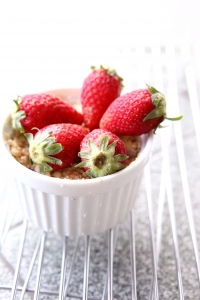 Berries pack a powerful punch nutritionally, and they’re delicious and easy to build recipes around. They’re low in calories and full of antioxidants, minerals, and vitamins. For example, one cup of strawberries contains as much vitamin C as a glass of orange juice, potassium, and magnesium. Blueberries, cranberries, and raspberries may help reduce risk of cancer.
Berries pack a powerful punch nutritionally, and they’re delicious and easy to build recipes around. They’re low in calories and full of antioxidants, minerals, and vitamins. For example, one cup of strawberries contains as much vitamin C as a glass of orange juice, potassium, and magnesium. Blueberries, cranberries, and raspberries may help reduce risk of cancer.
For best results, purchase berries from farmers markets or pick your own. If that’s not possible, buy berries in season at the grocery store, or try frozen berries. The advantage to frozen berries is that you can buy them in large quantities and not have to worry about spoilage.
The most common way to eat berries is straight from the bag. Other ways to enjoy berries include:
- Mixing them in with cottage cheese, ice cream, cream cheese, or Greek yogurt for a delicious treat.
- Combining with protein powder, other fruit, water, and ice to make a healthy smoothie.
- Sprinkling them on salad, oatmeal, or cereal.
Berries make a flavorful, sweet addition to any recipe. Here are a few we know you’ll enjoy:
Strawberry Basil Salsa
2 tablespoons lemon juice
1 tablespoon extra virgin olive oil
1/4 teaspoon salt
Pinch Ground black pepper
2 tablespoons minced shallot
2 tablespoons thinly sliced fresh basil leaves
1 package (16 ounces) Driscoll’s Strawberries
Whisk together lemon juice, oil, salt, and pepper in a medium bowl.
Stir in shallot and basil.
Hull strawberries and chop (you should have about 3 cups.)
Add to lemon juice mixture and stir until evenly blended.
Healthy Blueberry Bran Muffin
1 cups whole wheat flour
3/4 cups all-purpose flour
2/3 cups packed brown sugar
1/3 cups flaxseed meal
1/3 cups raw wheat or oat bran
1 1/2 teaspoons baking powder
1/2 teaspoons baking soda
1/4 teaspoons salt
1 cup low-fat vanilla yogurt
2 tablespoons canola or vegetable oil
1/4 cups orange juice or water
2 large eggs
1 package (6 ounces or 1 1/3 cups) Driscoll’s Blueberries
Preheat oven to 400°F.
Line 12 muffin cups with papers or coat with cooking spray.
Combine flours, sugar, flaxseed, wheat bran, baking powder, baking soda, and salt in a large bowl; stir well.
Stir together yogurt, oil, eggs, and juice in a small bowl.
Add yogurt mixture to flour mixture; stir just until blended.
Fold in blueberries just until batter is completely moistened.
Divide batter between prepared muffin cups.
Remove muffins from pan and cool on wire rack.
Bake 18 minutes or until golden brown and pick inserted in center comes out clean.
Mascarpone Dip with Basil Blackberries
1/3 cups balsamic vinegar
1 teaspoon light brown sugar
1 package (6 ounces or 1 1/2 cups) Driscoll’s Blackberries
2 tablespoons thinly sliced basil leaves
1/2 teaspoons freshly ground black pepper
Large pinch of fleur de sel or other flaky salt
1 container (8 to 8.8 ounces) mascarpone cheese
Crackers, for serving
Bring vinegar and brown sugar to a boil in a nonreactive small saucepan over high heat. Boil until reduced to 2 tablespoons. Pour into a medium bowl. Let cool.
Gently stir in blackberries, basil, pepper, and salt.
Fill a bowl with hot water. Dip bottom of the mascarpone container in water for about 5 seconds. Using a rubber spatula, unmold mascarpone onto a serving platter.
Spoon blackberry mixture over mascarpone, being sure to scrape all juices out of the bowl, and letting berries fall randomly.
Serve with crackers.
Source: http://www.driscolls.com/recipes






